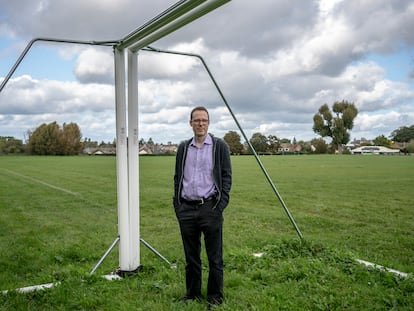Rodrygo Goes, alpha brain waves and being in the zone
Neuroscience has identified the electrical frequencies that explain good and bad streaks

After Real Madrid beat Granada last Saturday, Manager Carlo Ancelotti said something that sounded like old soccer wisdom. And it was; but it was also something that has found support in advanced mathematics and neurophysiology and the knowledge of brain waves: “When he’s in good form, Rodrygo scores from the center, from the left or from the right.” The Brazilian had just scored for the fifth consecutive game: seven goals in total. The fact that he had scored from the right flank, where it was said that he was not comfortable, further confirmed that Rodrygo was on a roll after having gone through a fierce slump.
It was a terrible period. The Brazilian scored with his first shot of the season on August 12, at the San Mamés Stadium. Then he tried 41 more times over the course of two and a half months, until October 22, when he scored again in Braga (Portugal). If we add up the value of all the chances he had up until that moment, Rodrygo had wasted 3.63 expected goals (xG), according to the StatsBomb model. In that moment, he was the worst-shooting player in Europe.
Ancelotti, seasoned in all battles, knew that it was bound to change. “We have to be patient, because these are moments that especially forwards go through. There are times when you score every time you touch the ball, and there are times when you shoot a lot and fail. It will pass, as it has happened with all other forwards.” He said this at a still delicate point on the calendar. It was November 7th. Rodrygo had scored two weeks earlier, and then nothing for two games. But the Italian sensed that something was about to change, and he was right.
The next day, Rodrygo scored a goal against Braga at the Santiago Bernabéu Stadium, and he scored again in the next four games, until the goal he scored against Granada. Ancelotti sensed — as soccer people sense — that one goal never comes alone. This phenomenon has always been taken for a fact, also in other sports like basketball, where it is known as a “hot hand”: after scoring several consecutive shots, the shooter enters “the zone” and feels that they will continue to shoot better. The players believe it, as well as the coaches, who call for time-outs to interrupt the moment of inspiration. However, for decades, cognitive psychology maintained that this was only an illusion.
In 1985, three psychologists dedicated to uncovering cognitive biases, Thomas Gilovich, Robert Vallone and Amos Tversky, suspected that the hot hand was nothing but a form of self-deception, and set out to debunk it. They examined shot data to see if a player was more likely to score after a series of successful shots than under normal conditions, and they came to the conclusion that it was nothing but chance, and that the athletes who believed in streaks, or zones, or Ancelotti’s “good form,” were only being superstitious.
Over the next 30 years, researchers around the world designed similar studies that reinforced the reputation of the so-called hot hand fallacy, which became an extremely popular concept. That is, until 2015, when two economists, Joshua Miller and Adam Sanjurjo, reviewed the data from that canonical 1985 study and realized that Gilovich’s team had misread it. Their records actually showed the opposite: scoring was indeed more likely after a series of successful shots. The hot hand was right there, in the data.
Neurological studies have also found signs of momentum in the brain. They are the high alpha brain waves, explains José Adán, head of the neurotraining unit at the RX2 Sports & Health Center in Madrid, Spain. “The measurement of the high alpha brain wave is a great indicator to separate the greats from the good athletes. It appears at times of peak performance,” he says. “Those who don’t stand out at key moments have a lower high alpha frequency during the activity. With more high alpha, you have the ability to shift attention very quickly, with an external focus of attention; alert and calm at the same time,” he continues. “It is a state in which everything flows. The brain does what it has to do at all times without obstacles, without rumination of thoughts, worries or expectations, which waste a lot of energy.”
Bad streaks like Rodrygo’s usually shift the focus inward, on thoughts about failures, their consequences, their effects. “That can destabilize. You spend twice the energy. When the brain faces more obstacles, it affects the performance,” says Adan. The mind becomes stagnant and the performance suffers.
After Rodrygo’s long streak of two and a half months of missed shots, when he finally scored it was thanks to an easier opportunity than all the previous ones: he had 0.44 xG. Before that, he had wasted two very juicy ones, one of 0.40 against Real Sociedad and another of 0.35 against Union Berlin. However, the goal in Braga was still not enough to put him in the zone. He missed his next seven shots, and he kept missing until he found another relatively easy chance with a 0.42 xG. That is when things took a turn for him: with his next 14 shots he scored five goals, and the best chance he missed was only 0.18 xG.
Up until October 31, there were 361 soccer players in Europe who had participated in more goals than Rodrygo, according to the Opta sports analytics firm. Since November 1, however, no one has participated in more goals than him.
Sign up for our weekly newsletter to get more English-language news coverage from EL PAÍS USA Edition
Tu suscripción se está usando en otro dispositivo
¿Quieres añadir otro usuario a tu suscripción?
Si continúas leyendo en este dispositivo, no se podrá leer en el otro.
FlechaTu suscripción se está usando en otro dispositivo y solo puedes acceder a EL PAÍS desde un dispositivo a la vez.
Si quieres compartir tu cuenta, cambia tu suscripción a la modalidad Premium, así podrás añadir otro usuario. Cada uno accederá con su propia cuenta de email, lo que os permitirá personalizar vuestra experiencia en EL PAÍS.
¿Tienes una suscripción de empresa? Accede aquí para contratar más cuentas.
En el caso de no saber quién está usando tu cuenta, te recomendamos cambiar tu contraseña aquí.
Si decides continuar compartiendo tu cuenta, este mensaje se mostrará en tu dispositivo y en el de la otra persona que está usando tu cuenta de forma indefinida, afectando a tu experiencia de lectura. Puedes consultar aquí los términos y condiciones de la suscripción digital.
More information
Archived In
Últimas noticias
Most viewed
- Reinhard Genzel, Nobel laureate in physics: ‘One-minute videos will never give you the truth’
- Oona Chaplin: ‘I told James Cameron that I was living in a treehouse and starting a permaculture project with a friend’
- Pablo Escobar’s hippos: A serious environmental problem, 40 years on
- Why we lost the habit of sleeping in two segments and how that changed our sense of time
- Charles Dubouloz, mountaineering star, retires at 36 with a farewell tour inspired by Walter Bonatti











































